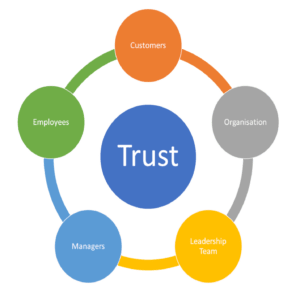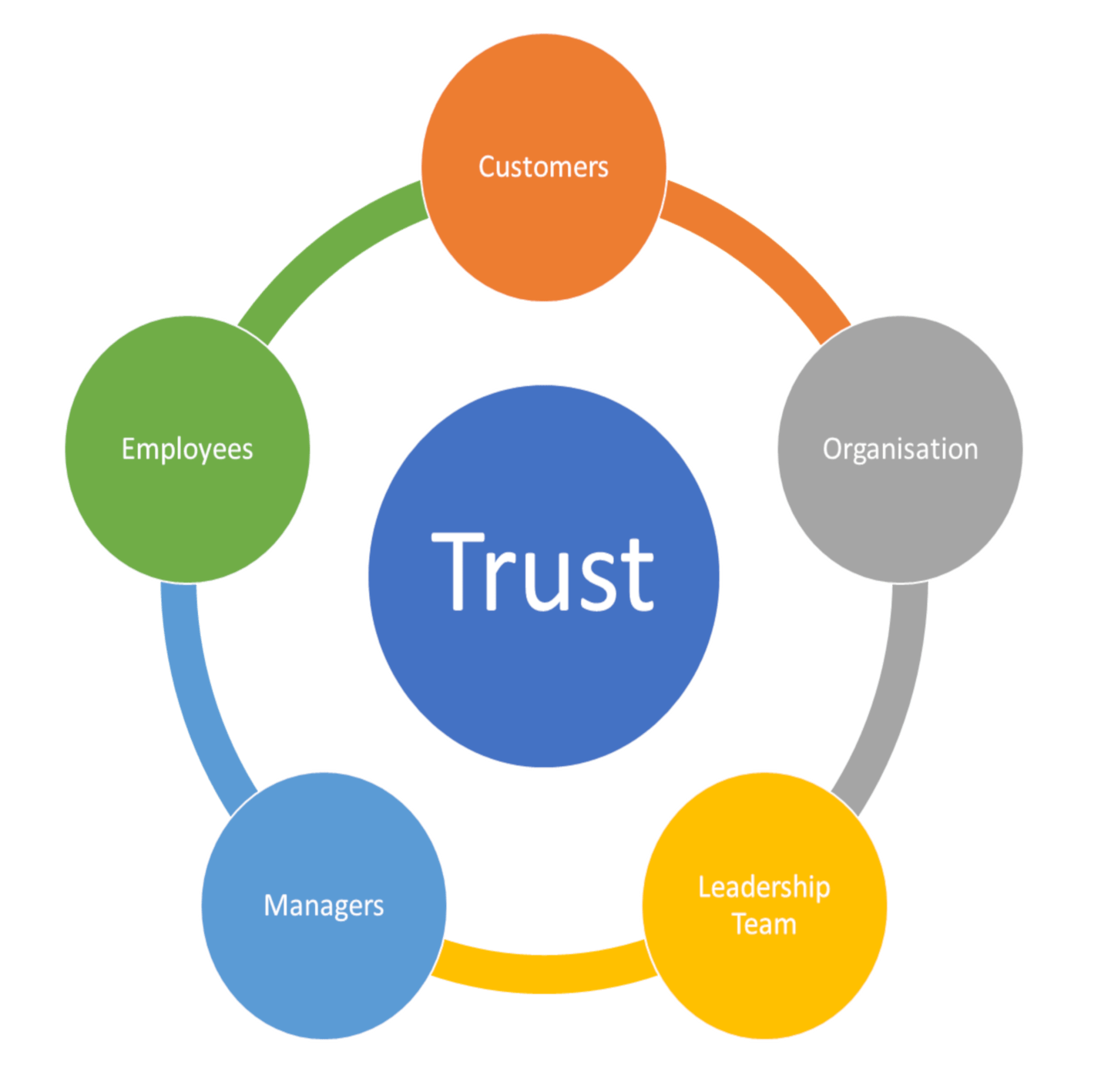Trust has become an important topic in today’s business environment. Improving workplace trust levels has become increasingly recognised as key to long-term organisational effectiveness and success. If we can understand better how trust is built and how trust is maintained, we can manage those relationships better and that will help businesses to thrive.
Power of Trust

Several studies have shown now that if people trust their leaders, they reciprocate in kind by demonstrating superior customer service, which translates into better sales, which translates into better performance.
‘… trust works as a lubricant in economic transactions by smoothing relations between actors and reducing transaction costs related to control’
(Bijlsma and van de Bunt, 2003, p. 639)

Dr Graham Dietz from Durham University explains with trust, staff & customer satisfaction go up. Key performance indicators for maintenance and for dealing with customer complaints clearly and evidently conclude with increasing trust, the organisation becomes more efficient, more effective, understands customer needs better and is more responsive.
He further noted trust is absolutely crucial to how all organisations function. All organisations thrive and rely on the relationships that they have internally and the relationships that they have externally. Without trust, you have no business.
Stephen Covey, in his book The “8th Habit”, describes a poll of 23,000 full-time employees drawn from several companies and key industries. some of the main findings were:
- Only 37% said they have a clear understanding of what their organization is trying to achieve and why
- Only one in five was enthusiastic about their team’s and their organization’s goals
- Only one in five said they had a clear “line of sight” between their tasks and their team’s and organization’s goals
- Only 15% felt that their organization fully enables them to execute key goals
- Only 20% fully trusted the organization they work for
Above reinforces the importance and consequences of trust, So let’s discuss the following questions:
- What inspires trust inside the organisation?
- What are the dynamics of trust, and how can it help performance and employee well-being?
What is trust in an Organisation?
The definition of trust usually involves two specific parties: a trusting party (‘trustor’) and a party to be trusted (‘trustee’), along with notions of ‘risk’ and ‘vulnerability’.
Trust as a threefold belief
Trust is defined as an individual’s belief or a common belief among a group of individuals that another individual or group
- makes good-faith efforts to behave following any commitments, both explicit or implicit,
- is honest in whatever negotiations preceded such commitments, and
- does not take excessive advantage of another even when the opportunity is available
Much of organizational interaction rests strongly on these three characteristics and thus makes trust so centrally important.
The challenge of trust in organisations
There is no doubt that trust is an appealing concept and one that is highly valued. In our daily lives, it is an important feature of our relationships and social adjustment. But trust does not necessarily sit easily in the context of organisational life. A multitude of changes internally and externally have led to the focus on developing and building trust, some of these are below:
- Flexible work arrangements: Homeworking, remote working, virtual working, and working different types of work schedules. This spatial and temporal dispersion of work renders traditional control and monitoring unviable and implies the need for a new type of interdependence and cooperation between workers and managers.
- Diversity: Diverse workforce across different geographical locations both nationally and internationally. Increased diversity within the workforce leads to the need for people to be able and willing to trust people with very different backgrounds.
- Knowledge worker age: More and more jobs now are increasingly focused around a strong customer service orientation, as well as ‘knowledge work’ and intellectual labour. Each of these types of work depends heavily on high levels of engagement and voluntary cooperation in work, again leading to a focus on cooperation and trust.
- A new way of working: Mythologies like Agile hierarchies are increasing becoming popular within organisations and thus flatter hierarchical structures and servant leadership. It means that formal controls and sanctions are minimal, and relationships between co-workers and management can be complex; trust becomes paramount.
The relevance of trust in organisations
When we talk about organisational actors and trust, it would be prudent to consider that not all organisational actors will attract the same amount or type of trust. Research has shown that different organisational actors at different levels within an organisation are indeed likely to be considered more or less trustworthy.
One particular finding is that senior managers are considered less trustworthy if they have more control. The relationship between trust and control has sparked some debate in the literature. However, most researchers agree that trust works as a substitute to control because it reduces transaction costs. Essentially, the higher the trust in a relationship, the lower the costs of monitoring, checks and other control mechanisms will be.
A related issue here is the role of leadership and the leadership culture within organisations. This is not just because it is managers and leaders who often instigate monitoring and control measures. Leadership culture cascades throughout an organisation and creates strong messages, both real and symbolic, about the nature of trust within organisations.
Put simply, leadership is a highly important factor in the level of trust within organisations.
CIPD concluded in their recently published reports that senior leaders play a pivotal role in trust relations throughout an organisation and that the cultivation of ‘trustworthy’ senior leaders underpins the challenge of creating cultures of organisational trust throughout the entire organisation.
Behavioural importance: Increased performance
Trust is positively associated with increased levels of performance (Dirks and Ferrin, 2002). Research has found that individuals who feel that their leader has demonstrated, or will, demonstrate care and consideration will reciprocate this sentiment in the form of desired behaviours.
A high trust social exchange relationship encourages people to spend more time on required tasks and be willing to go above and beyond their job role. High trust relationships have thus been found to result in higher performance and organisational citizenship behaviours.
A high trust social exchange relationship encourages people to spend more time on required tasks and be willing to go above and beyond their job role. High trust relationships have thus been found to result in higher performance and organisational citizenship behaviours.
Attitudinal importance: commitment, job satisfaction, intent to stay
Trust is also linked to many attitudinal outcomes, particularly organisational commitment and job satisfaction.
It is widely recognised that managers are responsible for many duties that have a major effect on employees’ job satisfaction, such as performance evaluations, guidance and assistance with job responsibilities, and training.
People are likely to feel safer and more positive about a manager making these decisions when they believe the leader is trustworthy.
In contrast, having a low level of trust in a leader is likely to be psychologically distressing when the leader has power over important aspects of one’s job and this distress is likely to affect one’s attitudes about the workplace.
The implication of this idea is that trust in leadership should be associated with higher levels of job satisfaction, higher organisational commitment and lower intention of quitting. Either way, quitting has all the obvious costs associated with turnover, while the intention to leave is empirically associated with low levels of engagement and organisational citizenship behaviours.

“The best way to find out if you can trust somebody is to trust them.”
Ernest Hemingway
References
CIPD. (n.d.). Where Has All the Trust Gone with Case Study | Reports | CIPD. Retrieved March 16, 2019, from https://www.cipd.co.uk/knowledge/culture/ethics/has-trust-gone-report
CIPD. (n.d.). Trustworthy Leadership Experience | Reports | CIPD. Retrieved March 16, 2019, from https://www.cipd.co.uk/knowledge/strategy/leadership/trust-report
CIPD. (n.d.). Trustworthy Leaders with Case Study | Reports | CIPD. Retrieved March 16, 2019, from https://www.cipd.co.uk/knowledge/strategy/leadership/trustworthy-leaders-report
OU. (n.d.). Developing high trust work relationships – OpenLearn – Open University – BG022_1. Retrieved March 17, 2019, from https://www.open.edu/openlearn/money-business/leadership-management/developing-high-trust-work-relationships/content-section-0
